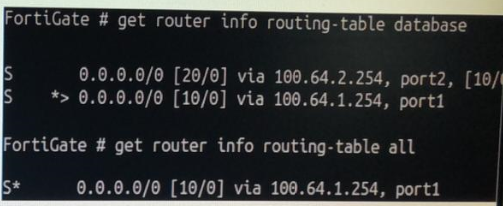Fortinet NSE 7—Enterprise Firewall 6.4 NSE7_EFW-6.4 Real Exam Questions
Fortinet NSE 7—Enterprise Firewall 6.4 NSE7_EFW-6.4 exam is the new version replacement of Fortinet NSE 7—Enterprise Firewall 6.2 NSE7_EFW-6.2 exam which will be no longer available after May 15,2021. To help you pass Fortinet NSE7_EFW-6.4 exam successfully, PassQuestion provides the high-quality Fortinet NSE 7—Enterprise Firewall 6.4 NSE7_EFW-6.4 Real Exam Questions that will help you pass your Fortinet NSE7_EFW-6.4 exam. NSE7_EFW-6.4 Real Exam Questions include a 100% passing guarantee that can boost your preparation for Fortinet NSE7_EFW-6.4 exam and you'll be able to pass NSE7_EFW-6.4 exam successfully.

Fortinet NSE 7—Enterprise Firewall 6.4 NSE7_EFW-6.4 Exam Overview
The Fortinet NSE 7—Enterprise Firewall 6.4 exam is part of the NSE 7 Network Security Architect program, and recognizes the successful candidate’s knowledge and expertise with Fortinet solutions in enterprise security infrastructure environments.The exam tests applied knowledge of the integration, administration, troubleshooting, and central management of an enterprise firewall solution composed of FortiOS 6.4, FortiManager 6.4, and FortiAnalyzer 6.4.
The Fortinet NSE 7—Enterprise Firewall 6.4 exam is intended for network and security professionals who are responsible for the design, administration, and support of an enterprise security infrastructure composed of many FortiGate devices.
Exam Details
Exam name: Fortinet NSE 7—Enterprise Firewall 6.4
Exam series: NSE7_EFW-6.4
Time allowed: 60 minutes
Exam questions: 35 multiple-choice questions
Scoring: Pass or fail, a score report is available from your Pearson VUE account
Language: English and Japanese
Product version: FortiOS 6.4, FortiManager 6.4, FortiAnalyzer 6.4
Exam Topics
Successful candidates have applied knowledge and skills in the following areas and tasks:
System and session troubleshooting
- Perform initial configuration
- Implement the Fortinet Security Fabric
- Security Fabric
- FortiOS architecture
- Traffic and session monitoring
- High availability
Central management
- Central management and analysis using FortiManager and FortiAnalyzer
Content inspection
- FortiGuard
- Web filtering
- Antivirus
- Intrusion Prevention System (IPS)
Routing and Layer 2 switching
- Static routing
- Dynamic routing: OSPF, Border Gateway Protocol (BGP)
VPN
- IPsec
- Autodiscovery VPN (ADVPN)
View Online Fortinet NSE 7—Enterprise Firewall 6.4 NSE7_EFW-6.4 Free Questions
View the exhibit, which contains the output of a debug command, and then answer the question below.

Which one of the following statements about this FortiGate is correct?
A.It is currently in system conserve mode because of high CPU usage.
B.It is currently in extreme conserve mode because of high memory usage.
C.It is currently in proxy conserve mode because of high memory usage.
D.It is currently in memory conserve mode because of high memory usage.
Answer : D
Refer to the exhibit, which contains partial outputs from two routing debug commands.

Why is the port2 default route not in the second command's output?
A.It has a higher priority value than the default route using port1.
B.It is disabled in the FortiGate configuration.
C.It has a lower priority value than the default route using port1.
D.It has a higher distance than the default route using port1.
Answer : D
Which statement about memory conserve mode is true?
A.A FortiGate exits conserve mode when the configured memory use threshold reaches yellow.
B.A FortiGate starts dropping all the new and old sessions when the configured memory use threshold reaches extreme.
C.A FortiGate starts dropping new sessions when the configured memory use threshold reaches red
D.A FortiGate enters conserve mode when the configured memory use threshold reaches red
Answer : C
Which two conditions must be met for a statistic route to be active in the routing table? (Choose two.)
A.The link health monitor (if configured) is up.
B.There is no other route, to the same destination, with a higher distance.
C.The outgoing interface is up.
D.The next-hop IP address is up.
Answer: A, C
When using the SSL certificate inspection method to inspect HTTPS traffic, how does FortiGate filter web requests when the client browser does not provide the server name indication (SNI) extension?
A.FortiGate uses the requested URL from the user's web browser.
B.FortiGate uses the CN information from the Subject field in the server certificate.
C.FortiGate blocks the request without any further inspection.
D.FortiGate switches to the full SSL inspection method to decrypt the data.
Answer: B
- TOP 50 Exam Questions
-
Exam
All copyrights reserved 2025 PassQuestion NETWORK CO.,LIMITED. All Rights Reserved.

